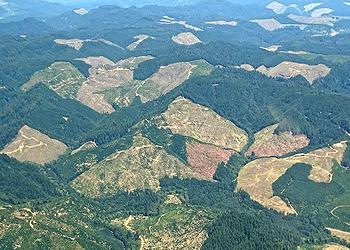
OAKLAND, California, August 8, 2016 (ENS) – At the Oakland office of the international sustainability think tank Global Footprint Network, August 8 is a special day, as it is at the GFN offices elsewhere around the world. It’s Earth Overshoot Day, the date when humanity has used up all the natural resources the planet can renew in the entire year.
The Global Footprint Network, GFN, and its partners have taken it upon themselves to educate humanity about Earth Overshoot Day and its consequences.
Earth Overshoot Day has come a little earlier every year as humans eat ever more deeply into the planet’s resources, throwing the entire system into ecological deficit.

“As both domestic and global pressures on nature’s resources increase, it is more important than ever to manage them carefully in order to ensure the most resilient future for our country and its states,” says Mathis Wackernagel, president of Global Footprint Network and co-creator of the Ecological Footprint.
“We strongly believe it is possible to live within the means of nature, without sacrificing human well-being,” said Wackernagel. “But doing so requires decision-makers to make strategic investments in infrastructure and our natural capital and set policies aimed at conserving our planet’s resources.”
By 2030, we would have to mark Earth Overshoot Day in June if current trends don’t change,” projected Wackernagel, writing in “The Hindu” newspaper last Earth Overshoot Day on August 13, 2015.
“An ecological overshoot is possible only for a limited time before ecosystems begin to degrade and possibly collapse,” observes network partner the gobal conservation group WWF.
“Nature’s services are crucial to our well-being, prosperity and happiness, and to our very survival. So we must shift from being irresponsible exploiters to careful stewards and good managers of the planet’s essential, finite resources,” said Marco Lambertini, director general, WWF International in a statement published on overshootday.org.
“Earth Overshoot Day must serve as a stark reminder of the actions we need to urgently take on an individual, country and global level to respect planetary boundaries and achieve sustainability and resilience for all,” Lambertini said.
The United States busted its national annual ecological budget on July 14, using more resources and services than U.S. ecosystems can regenerate over the entire year, according to the Global Footprint Network.
“The population of the United States is using twice the renewable natural resources and services that can be regenerated within its borders,” finds the GFN report, “State of the States: A New Perspective on the Wealth of Our Nation.”

A state or country can run an ecological deficit by meeting demand through importing, liquidating its own ecological assets, such as overfishing or clearcut logging, and/or emitting carbon dioxide into the atmosphere.
Carbon dioxide makes up 67 percent of the Ecological Footprint of the entire United States, up from 53 percent in 1961, according to GFN figures.
The GFN report details the Ecological Footprint and resource availability of 50 states and the District of Columbia.
The Ecological Footprint is calculated as the sum of all land areas needed for food; fiber and timber for products like furniture and clothing; infrastructure such as housing and roads; and absorption of carbon emissions from burning fossil fuels.
The Ecological Footprint then can be compared to how much productive area is available within each state to provide for these services, defined as biocapacity.
Created in collaboration with Earth Economics in Tacoma, Washington, the GFN’s “State of the States” report finds that resource consumption and availability varies widely state by state.
The states with the largest per-person Ecological Footprints are Virginia, Maryland, and Delaware.
The states with the smallest per-person Ecological Footprints are New York, Idaho, and Arkansas.
Alaska, Texas, and Michigan are the most resource-abundant states based on biocapacity, a measure of bioproductive land.
The states with the least biocapacity are Rhode Island, Delaware, and Arizona.
David Batker, executive director of Earth Economics, said, “People need nature. Economies need nature. Securing prosperity in the 21st century requires using informed measures, like the Ecological Footprint, to improve policy, shift investment and fix our ecological budget.”
California, Texas, and Florida have the highest ecological deficits. A state runs an ecological deficit when its demand for resources, or Ecological Footprint, exceeds what nature can regenerate within the state borders, or its biocapacity.
An ecological deficit is possible because states can import goods, overuse their resources – for instance, by overfishing and overharvesting forests – and emit more carbon dioxide into the atmosphere than can be absorbed by their own forests.
Alaska, South Dakota, and Montana have the greatest ecological reserves. A state has an ecological reserve when its biocapacity exceeds its Ecological Footprint.
“California provides a vivid example of the risks posed by resource constraints,” says GFN in its report. “The state’s four-year drought has resulted in historic limits on water usage, more than $2 billion of lost agriculture revenue, and battles over water rights.”
States can easily access resources beyond their borders through trade. However, such dependence could come at growing costs and exposure to volatility.
Carbon emissions contribute to climate change, which poses varying risks to states. In Texas, for instance, temperature increases will likely reduce crop yields, especially for cotton, the state’s largest crop.
The Global Footprint Network advocates transitioning to renewable energy as one of the most powerful ways to reduce the Ecological Footprint of states and nations.
Copyright Environment News Service (ENS) 2016. All rights reserved.
© 2016, Environment News Service. All rights reserved. Content may be quoted only with proper attribution and a direct link to the original article. Full reproduction is prohibited.
